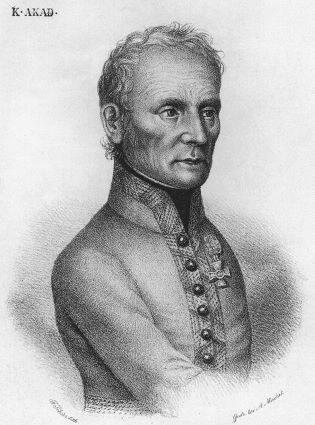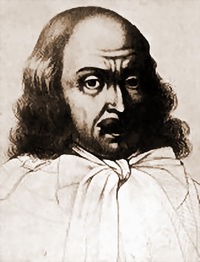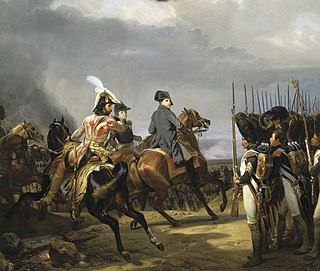Related Research Articles

Karl Freiherr Mack von Leiberich was an Austrian officer. He is best remembered as the commander of the Austrian forces that capitulated to Napoleon's Grande Armée in the Battle of Ulm in 1805.

Helmuth Johannes Ludwig Graf von Moltke, also known as Moltke the Younger, was a German general and Chief of the Great German General Staff, a member of the House of Moltke. He was also the nephew of GeneralfeldmarschallGraf Helmuth Karl Bernhard von Moltke, who is commonly called "Moltke the Elder" to differentiate the two.

Otto Ferdinand Graf von Abensperg und Traun, was an Austrian Generalfeldmarschall. The current spelling of the name, and the spelling used in his time, is mostly Abensperg.

Eduard Freiherr von Böhm-Ermolli was an Austrian general during World War I who rose to the rank of field marshal in the Austro-Hungarian Army. He was the head of the Second Army and fought mainly on the front of Galicia during the entire conflict. On 30 October 1940, Böhm-Ermolli was made a German Generalfeldmarschall.

A Generaloberst was the second-highest general officer rank in the German Reichswehr and Wehrmacht, the Austro-Hungarian Common Army, the East German National People's Army and in their respective police services. The rank was equal to a four-star full general but below a general field marshal. The rank was equivalent to a Generaladmiral in the Kriegsmarine until 1945 or to a Flottenadmiral in the Volksmarine until 1990. It was the highest ordinary military rank and the highest military rank awarded in peacetime; the higher rank of general field marshal was awarded only in wartime by the head of state. In general, a Generaloberst had the same privileges as a general field marshal.

Archduke Albrecht Friedrich Rudolf Dominik of Austria, Duke of Teschen, was an Austrian Habsburg general. He was the grandson of Emperor Leopold II and one of the chief military advisors of Emperor Francis Joseph I. As Inspector General for 36 years, he was an old-fashioned bureaucrat who largely controlled the Austro-Hungarian Army and delayed modernization. He was honored with the rank of Field Marshal in the armies of Austria-Hungary (1863) and Germany (1893).
Hans-Georg von Friedeburg was a German admiral, the deputy commander of the U-boat Forces of Nazi Germany and the second-to-last Commander-in-Chief of the Kriegsmarine. He was the only representative of the armed forces to be present at the signing of the German instruments of surrender in Luneburg Heath on 4 May 1945, in Reims on 7 May and in Berlin on 8 May 1945. Von Friedeburg committed suicide shortly afterwards, upon the dissolution of the Flensburg Government.

Franz Freiherr von Mercy, Lord of Mandre and Collenburg, was a German field marshal in the Thirty Years' War who fought for the Imperial side and was commander-in-chief of the Bavarian army from 1643 to 1645. In that role, he destroyed a French army at Tuttlingen (1643), stalemated another at Freiburg (1644), destroyed a third French army at Herbsthausen (1645) and was killed at the Second Battle of Nördlingen (1645).

The Battle of Würzburg was fought on 3 September 1796 between an army of the Habsburg monarchy led by Archduke Charles, Duke of Teschen and an army of the First French Republic led by Jean-Baptiste Jourdan. The French attacked the archduke's forces, but they were resisted until the arrival of reinforcements decided the engagement in favor of the Austrians. The French retreated west toward the Rhine River. The action occurred during the War of the First Coalition, part of the French Revolutionary Wars. Würzburg is 95 kilometres (59 mi) southeast of Frankfurt.
The X Corps of the Grande Armée was a French military unit that existed during the Napoleonic Wars. The corps was first formed in 1807 and placed under the command of Marshal François Joseph Lefebvre. The corps was responsible for bringing the Siege of Danzig to a successful conclusion. During the French invasion of Russia in 1812, the corps was reconstituted and Marshal Jacques MacDonald appointed to lead it. The corps contained a Prussian contingent that went on to form the core of the reformed Prussian Army in 1813. Following the retreat from Russia, the X Corps was given the assignment of holding Danzig under the leadership of General Jean Rapp. The Siege of Danzig lasted from January 1813 until January 1814 when the garrison surrendered.

The Battle of Párkány was fought between October 7–9, 1683 in the town of Párkány, in the Ottoman Empire, and the area surrounding it as part of the Polish-Ottoman War and the Great Turkish War. The battle was fought in two stages. In the first stage Polish troops under John III Sobieski were defeated by the Ottoman army under Kara Mehmed Pasha on October 7, 1683. In the second stage Sobieski, supported by Austrian forces under Charles V, Duke of Lorraine, defeated the Ottoman forces, which were supported by the troops of Imre Thököly, and gained control of Párkány on October 9, 1683. After the Ottoman defeat, the Austrians would besiege Esztergom and captured it at the end of 1683.

The Battle of Ettlingen or Battle of Malsch was fought during the French Revolutionary Wars between the armies of the First French Republic and Habsburg Austria near the town of Malsch, 9 kilometres (6 mi) southwest of Ettlingen. The Austrians under Archduke Charles, Duke of Teschen tried to halt the northward advance of Jean Victor Marie Moreau's French Army of Rhin-et-Moselle along the east bank of the Rhine River. After a tough fight, the Austrian commander found that his left flank was turned. He conceded victory to the French and retreated east toward Stuttgart. Ettlingen is located 10 kilometres (6 mi) south of Karlsruhe.

The Battle of Verona was fought on 18 October 1805 between the French Army of Italy under the command of André Masséna and an Austrian army led by Archduke Charles, Duke of Teschen. By the end of the day, Massena seized a bridgehead on the east bank of the Adige River, driving back the defending troops under Josef Philipp Vukassovich. The action took place near the city of Verona in northern Italy during the War of the Third Coalition, part of the Napoleonic Wars.

The Battle of Neumarkt-Sankt Veit on 24 April 1809 saw a Franco-Bavarian force led by Marshal Jean-Baptiste Bessières face an Austrian Empire army commanded by Johann von Hiller. Hiller's numerically superior force won a victory over the Allied troops, forcing Bessières to retreat to the west. Neumarkt-Sankt Veit is located ten kilometers north of Mühldorf and 33 kilometers southeast of Landshut in Bavaria.

The Jena-Auerstedt campaign order of battle is listed below. The order of battle includes units from the First French Empire and the Kingdom of Prussia that fought each other in the campaign that included the decisive Battle of Jena-Auerstedt on 14 October 1806. The order of battle may be useful to trace the battles of Schleiz and Saalfeld, which occurred before Jena-Auerstedt, as well as battles and capitulations that happened after 14 October, such as Erfurt, Halle, Prenzlau, Pasewalk, Stettin, Waren-Nossentin, and Lübeck.

The Battle of Strasbourg Bridge was fought during the Swedish phase of the Thirty Years' War near the Free city of Strasbourg, in the Holy Roman Empire. Having dealt a heavy defeat on the Swedish army at the Battle of Nördlingen in September, the armies of the Emperor, Spain and the Catholic League overran much of the Swedish-held southern Germany. As a result, the Swedish commander, Rheingrave Otto Louis, decided to retreat over the Rhine with his army, using the Strasbourg bridge.

Adrian von Enkevort was a Brabantine nobleman and Generalfeldmarschall who fought during the course of the Thirty Years' War and the Franco-Spanish War (1635–59). He followed his father's footsteps becoming an officer, his first success came in 1632 when he distinguished himself at the Battle of Lützen, receiving the rank of Oberstleutnant in the forces of the Holy Roman Empire. He was later sent to the Rhine front where he assisted Charles of Lorraine in reclaiming his lost realm. After a short spell in the Spanish invasion of Picardy, he returned to the Rhine where he was captured by the French, spending three years in captivity. Upon his return in 1641, he was promoted to Generalfeldmarschall and dispatched to Germany where he campaigned extensively. In 1648, he became the supreme commander of the Bavarian forces, serving in this capacity until the end of the war. He was subsequently ennobled and received the sum of 3,000 Goldguldens for his service during the war. He died in 1663.
Ernst Graf von Trautson, actually Ernst Trautson von Falkenstein zu Sprechenstein und Schroffenstein, was an Austrian Roman Catholic clergyman who was Prince-Bishop of Vienna from 1685 to 1702.

Philipp Franz Emerich Karl von Stadion und Thannhausen was an Austrian feldmarschall-leutnant and Landkomtur of the Teutonic Order in Austria.
References
- 1 2 3 Millar 2008, p. 21.
- ↑ Streffleur 1863, p. 234.
- 1 2 Streffleur 1863, p. 235.
- 1 2 3 Staudinger 1885, p. 162.
- ↑ Streffleur 1863, p. 236.
- 1 2 3 4 5 6 7 8 9 10 Nafziger 1998.
- ↑ Staudinger 1885, p. 158.
- ↑ Staudinger 1885, p. 159-161.
- 1 2 Schuster & Francke 1885, p. 102.
- ↑ Schuster & Francke 1885, p. 102-103.